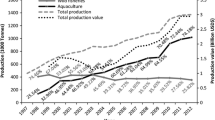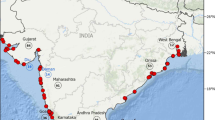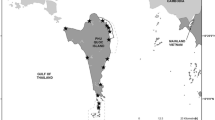Abstract
Seahorses (Hippocampus spp.) are globally threatened by overexploitation and habitat destruction; they are also regarded as susceptible to heavy exploitation due to some of their life-history traits. From an economic perspective, they are fishes with high monetary value and marketability. Seahorses are now listed in Appendix II of CITES (Convention on International Trade in Endangered Species of Wild Fauna and Flora), to ensure that the international trade is not detrimental to the survival of wild populations; the effectiveness evaluation of these international controls needs comparable monitoring data, including evaluation of spatial and temporal trends. This study assesses the seahorse trade in Brazil, aiming to detect trends in catch levels, volumes and prices. Our main findings were: the dried trade was unregulated, without formal records, and primarily domestic, although records of unreported exports existed; it was primarily sustained by incidental captures in trawl nets. The live seahorse trade was mainly destined for exports, and regulated through national quotas. Between 2002 and 2009, mean prices for dried seahorses ranged from US$1.06 ± 0.46 (level 1 traders) to US$2.78 ± 0.68 (end-sellers) each, while mean prices for each live seahorse traded on the domestic market (1997–2009) ranged from US$1.13 ± 0.02 (level 1 traders) to US$10.08 ± 1.71 (retailers). Mean declared export price (2006–2008) was 15.57 ± 10.87. Enhanced implementation of the CITES listing in Brazil will require further research, and additional measures to address both direct and indirect fishing pressure on seahorse populations.



Similar content being viewed by others
References
Albuquerque UP, Paiva RF (2004) Métodos e técnicas na pesquisa etnobotânica. Editora Livro Rápido/NUPEEA, Recife
Alves RRN, Pereira-Filho GA (2007) Commercialization and use of snakes on North and Northeastern Brazil: implications for conservation and management. Biodivers Conserv 16:969–985
Alves RRN, Rosa IL (2007) Zootherapy goes to town: the use of animal-based remedies in urban areas of NE and N Brazil. J Ethnopharmacol 113:541–555
Alves RRN, Rosa IML (2008) Use of tucuxi dolphin Sotalia fluviatilis for medicinal and magic religious purposes in North of Brazil. Hum Ecol 36:443–447
Alves RRN, Rosa IL (2010) Trade of animals used in Brazilian traditional medicine: trends and implications for conservation. Hum Ecol 38:691–704
Alves RRN, Rosa IL, Santana GG (2007) The role of animal-derived remedies as complementary medicine in Brazil. Bioscience 57:949–955
Bailey K (1994) Methods of social research. The Free Press, New York
Barros AT (2005) Taxonomia e análise da estrutura populacional comercializada de cavalos-marinhos (Syngnathidae: Teleostei: Hippocampus) no Brasil. Dissertation, Universidade Federal da Paraíba
Baum JK, Meeuwig JJ, Vincent ACJ (2003) Bycatch of lined seahorses (Hippocampus erectus) in a Gulf of Mexico shrimp trawl fishery. Fish Bull 101:721–731
Baum JK, Vincent ACJ (2005) Magnitude and inferred impacts of the seahorse trade in Latin America. Environ Conserv 32:305–319
Brown D, Swails E (2005) The convention on international trade in endangered species (CITES). Comparative case study 3. Verifor: options for forest verification. http://www.verifor.org/resources/case-studies/cites.pdf. Cited 31 Aug 2009
Bruckner AW (2001) Tracking the trade in ornamental coral reefs organisms: the importance of CITES and its limitation. Aquar Sci Conserv 3:79–94
Bruckner AW, Field JD, Davies N (eds) (2005) The proceedings of the international workshop on CITES implementation for seahorse conservation and trade. NOAA technical memorandum NMFS-OPR-36, Silver Spring
Casey SP, Hall HJ, Stanley HF et al (2004) The origin and evolution of seahorses (genus Hippocampus): a phylogenetic study using the cytochrome b gene of mitochondrial DNA. Mol Phylogenet Evol 30:261–272
Foster SJ, Vincent ACJ (2010) Tropical shrimp trawl fisheries: Fishers’ knowledge of and attitudes about a doomed fishery. Mar Policy 34:437–446
Fritzsche RR, Vincent ACJ (2002) Order Gasterosteiformes—Syngnathidade—Pipefishes and seahorses. In: Carpenter KE (ed) The living marine resources of western central Atlantic. Bony fishes—part 1 (Acipenseridae to Grammatidae). Food and Agriculture Organization of the United Nations, Rome
Giles BG, Truong SK, Do HH et al (2006) The catch and trade of seahorses in Vietnam. Biodivers Conserv 15(6):2497–2513
Hora MSC, Joyeux J-C (2009) Closing the reproductive cycle: growth of the seahorse Hippocampus reidi (Teleostei, Syngnathidae) from birth to adulthood under experimental conditions. Aquaculture 292:37–42
Huntington HP (2000) Using traditional ecological knowledge in science: methods and applications. Ecol Appl 10:1270–1274
IBAMA, Instituto Brasileiro do Meio Ambiente e dos Recursos Naturais Renováveis (2004) Instrução Normativa no. 14 de 18 de fevereiro de 2004. http://www.ibama.gov.br/
IBAMA, Instituto Brasileiro do Meio Ambiente e dos Recursos Naturais Renováveis (2008) Instrução Normativa no. 202 de 22 de outubro de 2008. http://www.ibama.gov.br/
IUCN (2010) IUCN red list of threatened species. Version 2010.4. http://www.iucnredlist.org. Cited 3 Jan 2011
Koldewey HJ, Martin-Smith KM (2010) A global review of seahorse aquaculture. Aquaculture 302(2010):131–152
Kuiter RH (2009) Seahorses and their relatives. Aquatic Photographics, Seaford
Lack M (2006) Conservation of Spiny Dogfish Squalus acanthias: a role for CITES?. TRAFFIC International, Cambridge
Lourie SA, Foster SJ, Cooper EWT et al (2004) A guide to the identification of seahorses. Project seahorse and TRAFFIC North America. University of British Columbia and World Wildlife Fund, Washington, DC
Martin-Smith KM, Vincent ACJ (2006) Exploitation and trade of Australian seahorses, pipehorses, sea dragons and pipefishes (family Syngnathidae). Oryx 40:1–11
McPherson JM, Vincent ACJ (2004) Assessing East African trade in seahorse species as a basis for conservation under international controls. Aquat Conserv 14:521–538
Meeuwig JJ, Do HH, Truong SK et al (2006) Quantifying non-target seahorse fisheries in central Vietnam. Fish Res 81:149–157
Ministério do Meio Ambiente (2004) Lista Nacional das Espécies de Invertebrados Aquáticos e Peixes Sobreexplotadas ou Ameaçadas de sobreexplotação. Instrução normativa no. 5, de 21 de maio de 2004. Diário Oficial da União, Brasília
Mulliken T (2009) The role of CITES in controlling the international trade in forest products implications for sustainable forest management. TRAFFIC International, Rome
Murphy JB (2006) Alternative approaches to the CITES “non-detriment” finding for Appendix II species. Environ Law 36:531–563
Nijman V (2010) An overview of international wildlife trade from Southeast Asia. Biodivers Conserv 19(4):1101–1114
Olivotto I, Avella AM, Sampaolesi G et al (2008) Breeding and rearing the longsnout seahorse Hippocampus reidi: rearing and feeding studies. Aquaculture 283:92–96
Pajaro MG, Meeuwig JJ, Giles BG et al (2004) Biology, fishery and trade of sea moths (Pisces: Pegasidae) in the central Philippines. Oryx 38(4):432–438
Perry AL, Lunn KE, Vincent ACJ (2010) Fisheries, large-scale trade, and conservation of seahorses in Malaysia and Thailand. Aquat Conserv 20:464–475
Phelps J, Webb EL, Bickford D et al (2010) Boosting CITES. Science 330(6012):1752–1753
Piacentino GLM, Luzzatto DC (2004) Hippocampus patagonicus sp. nov., nuevo caballito de mar para la Argentina (Pisces, Syngnathiformes). Rev Mus Argent Cienc Nat 6:339–349
Raymakers C (2006) CITES, the convention on international trade in endangered species of wild fauna and flora: its role in the conservation of Acipenseriformes. J Appl Ichthyol 22:53–65
Rivalan P, Delmas V, Angulo E et al (2007) Can bans stimulate wildlife trade? Nature 447:529–530
Roberts CM, Hawkins JP, Gell FR (2005) The role of marine reserves in achieving sustainable fisheries. Philos T R Soc B 360:123–132
Rosa IL (2005) National report—Brazil. In: Bruckner AW, Fields JD, Daves N (eds) The proceedings of the international workshop on CITES implementation for seahorse conservation and trade. NOAA technical memorandum NMFS-OPR-35, Silver Spring, pp 46–53
Rosa IL, Alves RRN, Bonifácio KM et al (2005) Fishers’ knowledge and seahorse conservation in Brazil. J Ethnobiol Ethnomed 1:12
Rosa IL, Sampaio CLS, Barros AT (2006) Collaborative monitoring of the ornamental trade of seahorses and pipefishes (Teleostei: Syngnathidae) in Brazil: Bahia state as a case study. Neotrop Ichthyol 4:247–252
Rosa IL, Oliveira TPR, Castro ALC et al (2007) Population characteristics, space use and habitat associations of the seahorse Hippocampus reidi (Teleostei: Syngnathidae). Neotrop Ichthyol 5:405–414
Sampaio CLS, Nottingham MC (2008) Guia para identificação de peixes ornamentais brasileiros-volume I: espécies marinhas. IBAMA, Brasília
Vincent ACJ (1996) The international trade in seahorses. TRAFFIC International, Cambridge
Wissenbach MCC (2004) A mercantilização da magia na urbanização de São Paulo, 1910–1940. Rev Hist 150:11–39
Acknowledgments
The first author wishes to thank Julia Baum (University of California) and Amanda Vincent (Project Seahorse), for their support and encouragement. We thank PADI Foundation, and PROBIO/MMA/IBRD/GEF/CNPq for financial support which allowed the collection of data; CAPES (Coordenação de Aperfeiçoamento de Pessoal de Nível Superior) provided a Ph.D. scholarship to A. L. C. Castro and to T. P. R. Oliveira, CNPq (Conselho Nacional de Desenvolvimento Científico e Tecnológico) provided research fellowships to I. L. Rosa and to R. R. N. Alves. Thanks are also due to Henrique Anatole (IBAMA) for providing access to official trade records. Special thanks are due to Ana Torres and Luiz Fernando (CEPSUL), and Antônio P. Clerton (CEPENE), for their invaluable support, and to our great PROBIO partners: Mara N. Carvalho (MPA), Alesandra B. Birolo (Ekko Brasil), Maria Elisabeth Araújo (UFPE), Adrianne Barros (UEPB), and Cassiano Monteiro-Neto (UFF). Lastly, we would like to thank all those who made time to provide us with information on the seahorse trade: Claúdio L. S. Sampaio, José de Anchieta Nunes, and the many interviewees we met along the way.
Author information
Authors and Affiliations
Corresponding author
Rights and permissions
About this article
Cite this article
Rosa, I.L., Oliveira, T.P.R., Osório, F.M. et al. Fisheries and trade of seahorses in Brazil: historical perspective, current trends, and future directions. Biodivers Conserv 20, 1951–1971 (2011). https://doi.org/10.1007/s10531-011-0068-2
Received:
Accepted:
Published:
Issue Date:
DOI: https://doi.org/10.1007/s10531-011-0068-2




